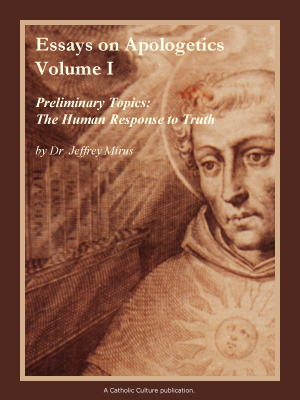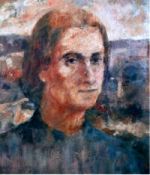Sing of Mary, 4a: Everything there is to know about the Mother of God, Part 1
By Dr. Jeff Mirus ( bio - articles - email ) | Dec 06, 2016 | In Reviews
One way to retreat from vexing situations, without failing to grow in our ability to handle them well, is to turn our attention to Mary, who faced so many of these situations without being able to change the unpleasant outcomes—outcomes which had their own role to play in Divine Providence. In thinking about this, I was reminded of how wonderful it would be to know more about Our Lady than we find in Scripture. And then I noticed the new book by Michael Hesemann from Ignatius: Mary of Nazareth: History, Archeology, Legends.
Free eBook:

|
| Free eBook: Essays in Apologetics, Vol. I |
I’ve read a little over a third of it, and I hope to share the wealth in two installments. The author has written 38 books, published in 14 languages. He teaches Church history in Rome. He has participated in archeological excavations in the Holy Land and helped to date a number of discoveries in Nazareth. He has advised and participated in TV programs for the Discovery Channel, the History Channel, and EWTN. He is the co-author with Msgr. Georg Ratzinger of My Brother, the Pope. And he has already written, in 2009, a book with no little relevance to the current volume: Jesus of Nazareth: Archeologists tracing down the Redeemer. That one, however, has not appeared in English.
Hesemann’s purpose is to gather together as much information about the Blessed Mother as can stand the test of critical examination, from Scripture of course; but also from the apocrypha (spurious scriptures which are not accepted as inspired by the Church but do represent remembrances and traditions—and, yes, embellishments—from very early times); and from other early legends; and from archeological studies at sites where we have good reason to believe Mary was present.
The author begins with a consideration of what is very likely the oldest image of Mary, the Advocata. This is now in the custody of the Convent of Our Lady of the Rosary in Rome, but it just may have been painted (using Egyptian techniques that no longer exist) by St. Luke himself. This image graces the cover of the book. Mary’s eyes are truly remarkable. Even in this printed copy, it is hard to ignore her steady gaze into our souls.
Piecing things together
In the early chapters, Hesemann does an excellent job of tying together historical records, the evidence in the apocryphal Gospel of Mary, and what we know of salvation history to outline the lives of Mary’s parents, Joachim and Anne; Mary’s birth and upbringing; her service in the temple as a child; and her betrothal to Joseph. He also notes the significance of King Herod’s announcement of plans to rebuild the Temple in 20-19 BC, an effort which exactly coincides with Mary’s birth. Herod’s efforts met considerable resistance and never reached the stage of ushering in the Messianic Age which the Jews believed would come with “the third temple”. But it was into precisely this culture of expectation of the Messiah that Mary was born. Was she not a new temple—in fact, a new Ark of the Covenant, since the original had been lost?
Stepping back just a bit, we learn that Joachim was in the Davidic line and Anne in the Levitical line, but to their sorrow, they were childless. Joachim had a good business in raising cattle for the Temple sacrifices, and he was very devout himself, often making double sacrifices, and sometimes being the first to do so. On a certain occasion, however, a priest rebuked him for making sacrifice since he had not fulfilled his obligation to raise up children for the Lord. Joachim returned home, and then went off to a nearby cave for extensive prayer and fasting; Anne did the same at home. Like Abraham and Sarah before them, and Zechariah and Elizabeth after them (not to mention Mary and Joseph), both received signs that they would have a child. The child, of course, was Mary, a name that could have quite a number of derivations, from the Hebrew, the Aramaic, the Syriac or the Latin. It could have meant something like “bitter sea”. But it could also have meant “The Beloved of God”.
In any case, Anne, when she learned she would conceive, dedicated her child, whether male or female, to God. At this time, young girls were selected to devote themselves to God in the Temple as children, before they became ritually unclean (at the onset of menstruation or at age 12, whichever came first). It is very likely that Mary became one of these “Daughters of Israel”, as they were called, living and serving in the Temple from perhaps four or five until age 12.
This service required a vow of virginity, and by the end of her service, Joachim and Anne were both dead. Therefore, it would have fallen to Mary’s uncle—none other than Zechariah himself—to select a husband and protector for her, an older man who was similarly committed to virginity, perhaps a member of the Essene community, which at that time honored this choice for men: In other words, at long last, St. Joseph.
Mary: Born in 19 BC, leaving the temple service in about 7 BC, betrothed to Joseph and married, as custom and law required, no more than a year later (and when Mary was no younger than 12 years and six months). The wedding would likely have been in 6 BC. It all fits. The best estimates of the year Our Lord was born are between 6 and 4 BC (as we will see later, Hesemann puts the birth in early March of the year 5 BC).
The Holy House at Loreto
Of course, Mary needed a home as soon as her Temple service ended, and the evidence is strong that Joseph took her into his home, a small but solid stone cottage in Nazareth. According to the Proto-Gospel, Joseph said: “See, I have received you from the Temple of the Lord. Now I am leaving you at home, while I go out to construct my buildings; later I will come back to you. The Lord will watch over you.” It was a good solid home, in a good and safe neighborhood.
This “Holy House”, as it was called, became the world’s foremost Marian shrine, before Lourdes and Fatima. It was recognized very early and almost certainly preserved by members of Our Lord’s extended family (who also served as bishops of Jerusalem in the first century or so after Christ). Churches were built on the site to honor and enclose the House. The annunciation took place there, and Mary’s fiat. Crusaders prayed there, including St. Louis IX in 1251. But in approximately 1291, Mary’s house disappeared from Nazareth. After several stops, it ended up in Loreto, Italy.
Legend attributes this to the work of angels, since God wished to protect the shrine from the Muslims. Of course, many have wondered whether the Holy House is a fraud, despite the building of over 2,000 replicas of it around the world by believers. Now, however, solid evidence shows that the materials, construction methods, and inscriptions in the Holy House are consistent only with its pre-existence in the Holy Land. Moreover, in the twentieth century the mystery of its translocation was finally solved. Evidence was found in the Vatican archives that the family of the Byzantine emperor had moved the house to Italy to preserve it. This was the Angeloi family, a probable source of the story about angels.
Since then, the original location of the house in Nazareth has been discovered, and in 2009 the Loreto house was proven to be an exact match for the foundations found there. Graffiti in the house (Loreto) and the immediate surroundings (Nazareth) are identical. But the role of the Byzantine royals does not explain everything. The stones that made up the house, which were moved and put back together in Italy, were eventually reconstructed without a foundation sitting in the middle of a road made of…sand. On that improbable surface, despite Our Lord’s parable about the man who build his house on sand, the Holy House has spent over seven hundred years. It is still completely intact today.
There is, I promise you, more to come. But this 250-page book is well worth reading in its entirety. If you need your soul lifted in our sea of troubles, Mary of Nazareth is up to the task.
Previous in series: Sing of Mary, 3: Living the Rosary
Next in series: Sing of Mary, 4b: Everything you wanted to know about the Mother of God, Part 2
All comments are moderated. To lighten our editing burden, only current donors are allowed to Sound Off. If you are a current donor, log in to see the comment form; otherwise please support our work, and Sound Off!







